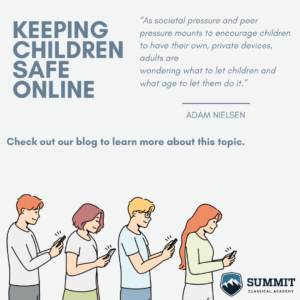
Parents, grandparents and educators alike are concerned about keeping children safe online. As societal
pressure and peer pressure mounts to encourage children to have their own, private devices, adults are
wondering what to let children and what age to let them do it. There are many risks associated with
children being online on personal or private devices. What works best may vary by age, family and/or
the individual child.
Physical risks are becoming well known and are documented by multiple sources including the Centers
for Disease Control. It is important to monitor children’s physical health in relation to device usage
including posture, vision, sleep cycles, and attention span.
Non-physical risks include data breaches (hacking) or data leaks, where children over time voluntarily
post information related to where they live, who they live with, family schedules and vacations, etc.
Internet luring is of great concern to law enforcement as it involves luring a child to do anything that
they would not normally do. This includes but is not limited to: substance use, providing personal or
family information, sneaking out, running away and more. Chat functions in games on websites have
been used by juvenile offenders alike to coordinate various criminal activities. Pop up ads can
circumvent age restrictions on devices allowing children to access inappropriate content. Parents should
be mindful of who children are chatting with, what content is being accessed and how technology is
being used. This is the “trust but verify” method. Anyone who has used an accountant to file their taxes
understands that we trust the accountant’s expertise but they will still provide you with a copy of the
tax return to verify that they were filed accurately and on time.
What age is appropriate for technology usage or social media accounts for children? This is a commonly
asked question. Parents talk with other parents, with educators, and with law enforcement about this
topic regularly. Again, this will vary by family and even by child within a family. There used to not be a
minimum age for technology usage in the chat room, AOL days. Technology providers and parent
advocacy groups realized that 10 years old was probably a minimum, this has moved up to 13 in recent
years and Florida recently codified in law that 14 years old would be the minimum age to access social
media sites. Again, this is a risk vs reward equation. What is the risk tolerance of your family and for
your child? Some parent groups have advocated for “When they can pay for the device themselves, they
can have one.” Maybe children should have to do chores or work to save up to purchase their device.
Because legislation was mentioned in this section, Florida is an outlier. States like Colorado are now
mandating that personal information including, preferred names, preferred pronouns and even medical
information must be kept from parents for children as young as 13 years old. Does this kind of legislative
trend work for you and your family?
What is the takeaway or the “call to action” from all of this information? It’s easy to say, “Do what’s best
for your child and your family”. But some tactics and suggestions may be helpful. Screen time is one
measure of appropriate technology use, but what about screen usage? What are the children looking at,
is it age appropriate, does it mesh with family values? In terms of “trust but verify”, parents can set up
Family Pairing on devices so that they are notified of screen time, screen usage, app downloads, etc.
Some of these notifications can spark conversations between parents and children, when devices are
used properly, children can be praised which is an obvious trust builder. Maybe there have already been
trust issues. Many hardware and software options are out there for parents to closely monitor their
child’s GPS location, exact screen usage and chat history. Gab watches, Apple Air Tags and Tiles will track
GPS location. Net Nanny and Safe Kids are apps to track screen usage.
Some of these topics can be heavy so it is probably appropriate to end with a biblical application. Who
would want to lure a child to provide personal information, or worse? Probably not someone wanting to
ensure the best for our children and certainly not someone wanting to ensure appropriate screen usage
or Christ centered technology usage. John 10:10 gives us a warning about who would want to expose
our children to inappropriate content and steal their innocence, “The thief comes only to steal and kill
and destroy; I have come that they may have life, and live it to the full.” Let’s ensure that the enemy
cannot steal, kill, or destroy our children and their youth.
Written by: Adam Nielsen – Adam Nielsen has 20 years of law enforcement experience focused on leadership, coaching, mentoring
and training. His experience includes a decade on a SWAT Team, over five years of undercover narcotics
experience and major case investigations that included crimes against children, internet crimes,
organized crime and persons crimes. He has a Bachelor’s degree in Sociology and a Master’s degree in
Criminology. More importantly, he is a proud husband and proud father to two young daughters.




